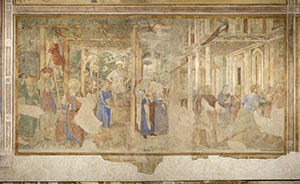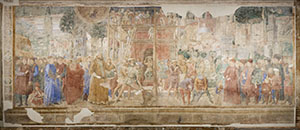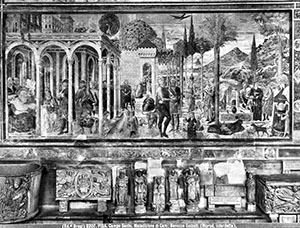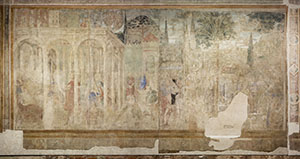
The Vintage and Drunkenness of Noah, Camposanto (Graveyard), Pisa.

The Building of the Tower of Babel, Camposanto (Graveyard), Pisa.

The Curse of Ham (photo 1890 approx.), Camposanto (Graveyard), Pisa.

The Curse of Ham, Camposanto (Graveyard), Pisa.
The frescoes that Benozzo Gozzoli painted for the Camposanto (Graveyard) of Pisa represent some of the most important works for understanding the ingenuity, excellence and ability of this painter, despite the fact that the paintings suffered irreparable damage during the bombardments of 1944.
Those who had the good fortune to admire them prior to this dramatic event could write that the frescoes of Benozzo seemed to make "that same leap that painting had made from Masaccio to Raffaello." Once again, this prolific artificer was defined "the Raffaello of the ancients."
In 1468, Benozzo began to paint twenty-six stories with episodes drawn from the old and the new Testaments on commission for the Opera Primaziale of Pisa - the lay institution that oversaw construction and preservation in Pisa. Two northern painters - Andrea Mantenga and Vincenzo Foppa - had already approached this entity in search of the prestigious assignment. Benozzo probably managed to obtain this job with the help of the Medici family's intervention (the arch-bishop of Pisa, Filippo di Vieri dei Medici, was a member of this powerful house).
Thanks to the precious incisions executed by Domenico Landini in the volume Pitture a fresco del Campo Santo di Pisa (Fresco paintings in the Camposanto (Graveyard) of Pisa), edited in Florence in 1812, and thanks to several photographs taken before the fire caused by a slug from an airplane in July of 1944, we can still get an idea of the paintings that Benozzo had frescoed on the west wall of the Camposanto (Graveyard) monument.
The layout and design of the scenes were imposed on Gozzoli by the previous pictorial decoration, begun in the mid-thirteenth century by Piero di Puccio and protracted until the end of the century, before being halted due to the political turmoil that was plaguing the city in those years. The painter subdivided the vast wall into two equal sections, each of which was partitioned into thirteen squares framed by a frieze decorated in antique style. Every story was accompanied by an inscription in common language, a sort of note that accompanied the figure that was depicted. Benozzo was skillful in coming up with inventive representations of these ancient stories, once again managing to translate the story into the daily context of his own times. Visitors to the prestigious Camposanto (Graveyard) monument, already a wonder of the peninsula during its own epoch, could recognize illustrious personalities and citizens of the times, in addition to complex, celebrated architectural works such as the Medici palace in Florence and the Pantheon of Rome.
Following the terrible catastrophe, this entire series of frescoes - including Gozzoli's paintings along with those of several other artists of the thirteenth century (Spinello Aretino, Bonamico Buffalmacco, Andrea Buonaiuti, Taddeo Gaddi, Piero di Puccio, Francesco Traini, Antonio Veneziano, Francesco da Volterra) and fifteenth-sixteenth century (Paolo Guidotti Borghesi, Agostino Ghirlanda, Aurelio Lomi and Zaccaria Rondinosi) - were subjected to a protection and strappo (detachment) intervention that was unparalleled in the history of restoration.
For obvious reasons, these operations were conducted with great caution and in many cases employed new intervention techniques and materials which, only afterwards, were sometimes discovered to have been inappropriate for preserving the paintings: though some of the consequences are still visible today, the choices made at that time (the only possible ones for the epoch) succeeded in rescuing what remained of these splendid masterpieces. By the end of the 1950s, some of the paintings had already been restored and remounted on plasterboard frames and returned to Camposanto (Graveyard), while others (Trionfo della Morte/ The Triumph of Death , Giudizio Universale/The Last Judgment , Inferno/The Hell, Storie degli anacoreti/Stories of the Anchorites , Crocifissione/Crucifixion and Ascensione/Ascension) were exhibited in a specially-prepared hall adjoining the monument. While some paintings were still being detached from the original walls, the technicians noticed problems of preservation with the already detached frescoes - deterioration caused by casein, the binder used during the emergency restoration operations. Thanks to new experiences with restoration – pursuant, unfortunately, to damage caused by flooding in Florence – an innovative new technique involving the use of fiberglass panels had been developed. The painted surface was re-attached to a double layer of hemp canvas, using acrylic resin as a binding agent instead of casein. To oversee this complex operation, the Opera Primaziale Pisana formed a standing scientific commission (a commission had previously been united to decide the museum-ing of the paintings in new and specially-prepared sites) made up of experts in the sector, including Umberto Baldini, director of the Opificio delle Pietre Dure (literally meaning Workshop for Hard Stones) at the time. Intervention guidelines were established, and a rigorous study aimed to return the entire series of paintings to their original site. A ‘pilot worksite' was established on the West wall, where periodic testing confirmed the absence of problems linked to further deterioration. It was deemed advisable to continue with the systematization of the frescoes on the East wall and to formalize a technical-scientific Management team consisting of Umberto Baldini (deceased in 2006, replaced by Antonio Paolucci), Clara Baracchini and Antonino Calca. In recent years, this Committee has been continuously engaged with this complex restoration. During the organizing of the frescoes on the original walls, it was discovered that the Buffalmacco series, in exhibition since 1960 in the hall adjoining Camposanto (Graveyard), was suffering from various types of deterioration. Excluded from restoration until the last moment, it has recently been subjected to in-depth diagnostic testing to evaluate its state of preservation and identify new and more appropriate intervention techniques.
The frescoes of Benozzo Gozzoli, after careful restoration, will also be able to return to their original site. Since 2005, the scenes with the Vendemmia e l'ebbrezza di Noè ( Grape harvest and the inebriation of Noah ), the Maledizione di Cam (Curse of Ham) and, most recently, the episode of the Costruzione della Torre di Babele (Construction of the Tower of Babel) have all been relocated. By 2011, the entire Gozzoli series will once again be viewable along the north wall of the Camposanto (Graveyard) monument of Pisa.
The Opera Primaziale Pisana is also committed to making this complex and prestigious restoration intervention available for reference by publishing the ongoing results of its work on the internet (http://www.opapisa.it/index.php?id=287).
Serena Nocentini